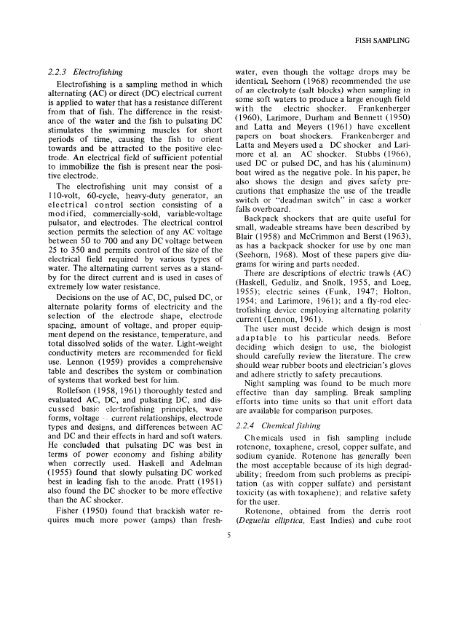Biological field and laboratory methods for measuring the quality of ...
Biological field and laboratory methods for measuring the quality of ...
Biological field and laboratory methods for measuring the quality of ...
You also want an ePaper? Increase the reach of your titles
YUMPU automatically turns print PDFs into web optimized ePapers that Google loves.
2.2.3 Electr<strong>of</strong>ishing<br />
Electr<strong>of</strong>ishing is a sampling method in which<br />
alternating (AC) or direct (DC) electrical current<br />
is applied to water that has a resistance different<br />
from that <strong>of</strong> fish. The difference in <strong>the</strong> resistance<br />
<strong>of</strong> <strong>the</strong> water <strong>and</strong> <strong>the</strong> fish to pulsating DC<br />
stimulates <strong>the</strong> swimming muscles <strong>for</strong> short<br />
periods <strong>of</strong> time, causing <strong>the</strong> fish to orient<br />
towards <strong>and</strong> be attracted to <strong>the</strong> positive electrode.<br />
An electrical <strong>field</strong> <strong>of</strong> sufficient potential<br />
to immobilize <strong>the</strong> fish is present near <strong>the</strong> positive<br />
electrode.<br />
The electr<strong>of</strong>ishing unit may consist <strong>of</strong> a<br />
llO-volt, 60-cycle, heavy-duty generator, an<br />
electrical control section consisting <strong>of</strong> a<br />
mod ified, commercially-sold, variable-voltage<br />
pulsator, <strong>and</strong> electrodes. The electrical control<br />
section permits <strong>the</strong> selection <strong>of</strong> any AC voltage<br />
between 50 to 700 <strong>and</strong> any DC voltage between<br />
25 to 350 <strong>and</strong> permits control <strong>of</strong> <strong>the</strong> size <strong>of</strong> <strong>the</strong><br />
electrical <strong>field</strong> required by various types <strong>of</strong><br />
water. The alternating current serves as a st<strong>and</strong>by<br />
<strong>for</strong> <strong>the</strong> direct current <strong>and</strong> is used in cases <strong>of</strong><br />
extremely low water resistance.<br />
Decisions on <strong>the</strong> use <strong>of</strong> AC, DC, pulsed DC, or<br />
alternate polarity <strong>for</strong>ms <strong>of</strong> electricity <strong>and</strong> <strong>the</strong><br />
selection <strong>of</strong> <strong>the</strong> electrode shape, electrode<br />
spacing, amount <strong>of</strong> voltage, <strong>and</strong> proper equipment<br />
depend on <strong>the</strong> resistance, temperature, <strong>and</strong><br />
total dissolved solids <strong>of</strong> <strong>the</strong> water. Light-weight<br />
conductivity meters are recommended <strong>for</strong> <strong>field</strong><br />
use. Lennon (1959) provides a comprehensive<br />
table <strong>and</strong> describes <strong>the</strong> system or combination<br />
<strong>of</strong> systems that worked best <strong>for</strong> him.<br />
Rollefson (1958,1961) thoroughly tested <strong>and</strong><br />
evaluated AC, DC, <strong>and</strong> pulsating DC, <strong>and</strong> discussed<br />
bask eledr<strong>of</strong>ishing principles, wave<br />
<strong>for</strong>ms, voltage- current relationships, electrode<br />
types <strong>and</strong> designs, <strong>and</strong> differences between AC<br />
<strong>and</strong> DC <strong>and</strong> <strong>the</strong>ir effects in hard <strong>and</strong> s<strong>of</strong>t waters.<br />
He concluded that pulsating DC was best in<br />
terms <strong>of</strong> power economy <strong>and</strong> fishing ability<br />
when correctly used. Haskell <strong>and</strong> Adelman<br />
(1955) found that slowly pulsating DC worked<br />
best in leading fish to <strong>the</strong> anode. Pratt (1951)<br />
also found <strong>the</strong> DC shocker to be more effective<br />
than <strong>the</strong> AC shocker.<br />
Fisher (1950) found that brackish water requires<br />
much more power (amps) than fresh-<br />
5<br />
FISH SAMPLING<br />
water, even though <strong>the</strong> voltage drops may be<br />
identical. Seehorn (1968) recommended <strong>the</strong> use<br />
<strong>of</strong> an electrolyte (salt blocks) when sampling in<br />
some s<strong>of</strong>t waters to produce a large enough <strong>field</strong><br />
with <strong>the</strong> electric shocker. Frankenberger<br />
(1960), Larimore, Durham <strong>and</strong> Bennett (1950)<br />
<strong>and</strong> Latta <strong>and</strong> Meyers (1961) have excellent<br />
papers on boat shockers. Frankenberger <strong>and</strong><br />
Latta <strong>and</strong> Meyers used a DC shocker <strong>and</strong> Larimore<br />
et al. an AC shocker. Stubbs (1966),<br />
used DC or pulsed DC, <strong>and</strong> has his (aluminum)<br />
boat wired as <strong>the</strong> negative pole. In his paper, he<br />
also shows <strong>the</strong> design <strong>and</strong> gives safety precautions<br />
that emphasize <strong>the</strong> use <strong>of</strong> <strong>the</strong> treadle<br />
switch or "deadman switch" in case a worker<br />
falls overboard.<br />
Backpack shockers that are quite useful <strong>for</strong><br />
small, wadeable streams have been described by<br />
Blair (1958) <strong>and</strong> McCrimmon <strong>and</strong> Berst (1963),<br />
as has a backpack shocker <strong>for</strong> use by one man<br />
(Seehorn, 1968). Most <strong>of</strong> <strong>the</strong>se papers give diagrams<br />
<strong>for</strong> wiring <strong>and</strong> parts needed.<br />
There are descriptions <strong>of</strong> electric trawls (AC)<br />
(Haskell, Geduliz, <strong>and</strong> Snolk, 1955, <strong>and</strong> Loeg,<br />
1955); electric seines (Funk, 1947; Holton,<br />
1954; <strong>and</strong> Larimore, 1961); <strong>and</strong> a fly-rod electr<strong>of</strong>ishing<br />
device employing alternating polarity<br />
current (Lennon, 1961).<br />
The user must decide which design is most<br />
adaptable to his particular needs. Be<strong>for</strong>e<br />
deciding which design to use, <strong>the</strong> biologist<br />
should carefully review <strong>the</strong> literature. The crew<br />
should wear rubber boots <strong>and</strong> electrician's gloves<br />
<strong>and</strong> adhere strictly to safety precautions.<br />
Night sampling was found to be much more<br />
effective than day sampling. Break sampling<br />
ef<strong>for</strong>ts into time units so that unit ef<strong>for</strong>t data<br />
are available <strong>for</strong> comparison purposes.<br />
2.2.4 Chemical fishing<br />
Chemicals used in fish sampling include<br />
rotenone, toxaphene, cresol, copper sulfate, <strong>and</strong><br />
sodium cyanide. Rotenone has generally been<br />
<strong>the</strong> most acceptable because <strong>of</strong> its high degradability;<br />
freedom from such problems as precipitation<br />
(as with copper sulfate) <strong>and</strong> persistant<br />
toxicity (as with toxaphene); <strong>and</strong> relative safety<br />
<strong>for</strong> <strong>the</strong> user.<br />
Rotenone obtained from <strong>the</strong> derris root<br />
(Deguelia elliptica, East Indies) <strong>and</strong> cube root















